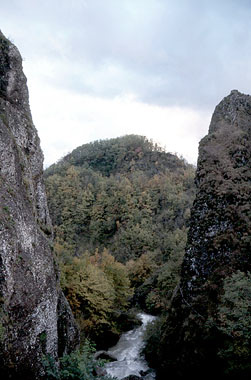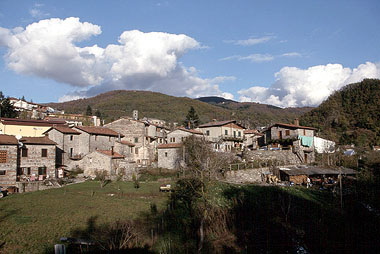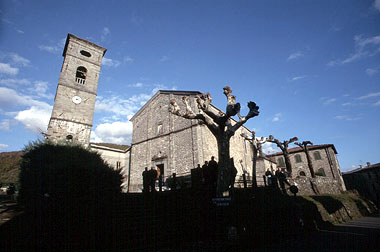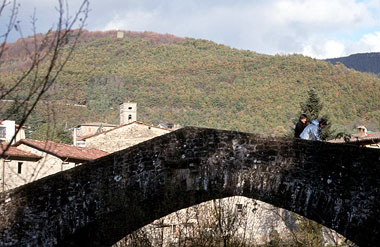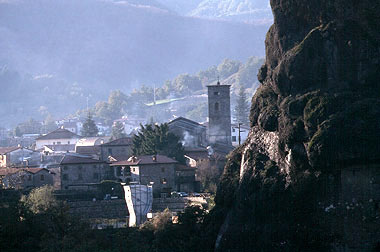Rocca of Castelvecchio

Information
Foundation:
Seconda metà del XI-XII secolo
District/Location:
Piazza al Serchio
District:
Garfagnana

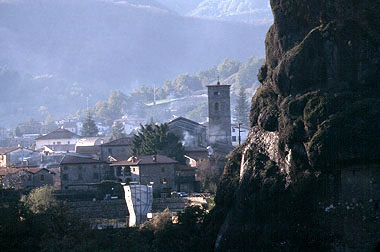
The fortified complex of Castelvecchio lies on a ridge at the junction of the routes linking Garfagnana respectively with the Po valley via the pass of Pradarena and with Lunigiana via the pass of Carpinelli, along two separate branches of the river Serchio. This bestows Piazza al Serchio considerable strategic relevance and importance as trade centre.
At the foot of the rocca is the small village of Sala: the ancient Sala Episcopi, seat of the bishopric of Pieve di Castello that administered part of the upper Serchio valley.
The fortification has an elongated irregular shape in conformity with the morphology of the ground; the walls are now just a thick curtain along the perimeter rising partially above the ground and made of local roughly hewn stone arranged in regular rows according to a widespread middle age technique.
We can reach the castle, along a steep winding path cut in the rock on the cliffside; there is only one gate on the south with a small guardhouse, few elements of which remain.
The structure was of strategic relevance because of its inaccessible position and the solidity of its construction; later, as the power of the bishopric waned it lost its political and military role; by the Renaissance it had been abandoned and had become a chestnut grove serving several different agricultural purposes.
At the foot of the rocca is the small village of Sala: the ancient Sala Episcopi, seat of the bishopric of Pieve di Castello that administered part of the upper Serchio valley.
The fortification has an elongated irregular shape in conformity with the morphology of the ground; the walls are now just a thick curtain along the perimeter rising partially above the ground and made of local roughly hewn stone arranged in regular rows according to a widespread middle age technique.
We can reach the castle, along a steep winding path cut in the rock on the cliffside; there is only one gate on the south with a small guardhouse, few elements of which remain.
The structure was of strategic relevance because of its inaccessible position and the solidity of its construction; later, as the power of the bishopric waned it lost its political and military role; by the Renaissance it had been abandoned and had become a chestnut grove serving several different agricultural purposes.
Piazza al Serchio
The wild undergrowth and the chestnut trees of the wood below have begun to envelop the fortifications. What remains are the walls, though not as high as they used to be and the foundations of some buildings inside, the castle's utilities.
The fortified structure is badly preserved and urgently needs works of consolidation and restoration of its walls in order to prevent further decay and allow a global appreciation of the construction. Recent excavation probes have yielded some interesting XIth-XIIth century pottery.
The fortified structure is badly preserved and urgently needs works of consolidation and restoration of its walls in order to prevent further decay and allow a global appreciation of the construction. Recent excavation probes have yielded some interesting XIth-XIIth century pottery.
The first document in which Castelvecchio is mentioned with such name dates from 1179; instead, in a Charter of Emperor Federico I dated 23rd March 1164 it is called Castello di Sala, from the name of the village below.
Looking at a map drawn in 1558 by Francesco Porta, a notary with a remarkable talent for drawing and rendering the relative positions of places, we can see that at the time the castle had already been abandoned: the area inside the walls, indeed, was a vineyard and that outside simply a field.
On the map, the guardhouse midway along the steep path is referred to as "porta ruinata" (ruined gate), a fact that proves the poor condition of the structure at the time.
Looking at a map drawn in 1558 by Francesco Porta, a notary with a remarkable talent for drawing and rendering the relative positions of places, we can see that at the time the castle had already been abandoned: the area inside the walls, indeed, was a vineyard and that outside simply a field.
On the map, the guardhouse midway along the steep path is referred to as "porta ruinata" (ruined gate), a fact that proves the poor condition of the structure at the time.
- GIOVANNETTI L., I siti fortificati dell'alta Garfagnana, in "La Garfagnana dall'epoca comunale all'avvento degli Estensi", atti del convegno tenuto a Castelnuovo Garfagnana il 13-14 settembre 1997, Modena, Aedes Muratoriana, 1998
Scopri altre attrazioni vicino a Rocca of Castelvecchio
See allYou may also like..
See allFind more
0








